 |
Obrázok
1 Klasifikačné systémy pri aortálnej disekcii
Figure 1 Classification systems of aortic dissection |
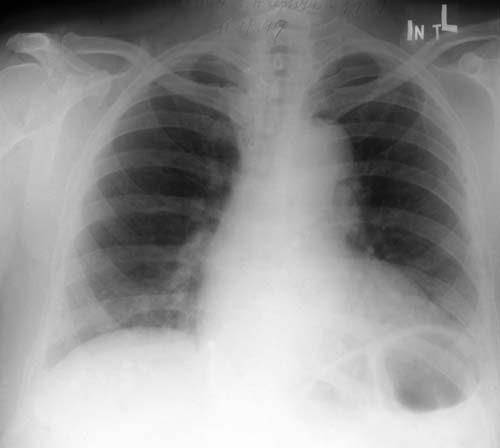 |
Obrázok
2A Skiagram hrudníka z 11. novembra 1999. Srdcový tieň je obojstranne rozšírený,
s aortálnou konfiguráciou, KTI = 0,57. Pľúcny parenchým je bez ložiskových zmien,
bilaterálne sú výraznejšie hily a tiež bronchovaskulárna kresba v dolných
pľúcnych poliach.
Figure 2A Chest roentgenogram demonstrates bilateral enlragement of the heart,
with an aortic configuration and CTI = 0.57. |
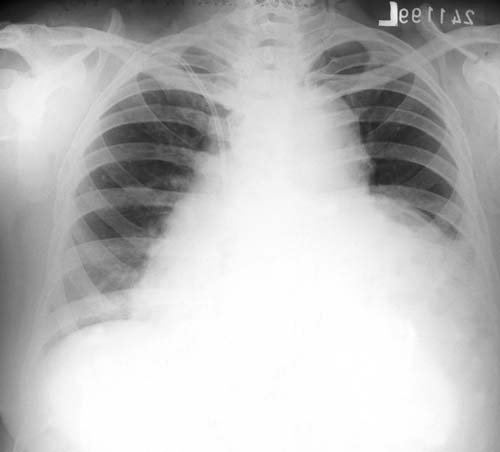 |
Obrázok
2B Zreteľné progresívne rozšírenie srdcového tieňa, pričom ľavá hranica
siaha až po laterálnu stenu hrudníka (24. novembra 1999). KTI = 0,75
Figure 2B There is evident progressive enlrargement of the heart compared with
the previous skiagram. The left heart border reaches the left chest wall (November 24,
1999). CTI = 0.75 |
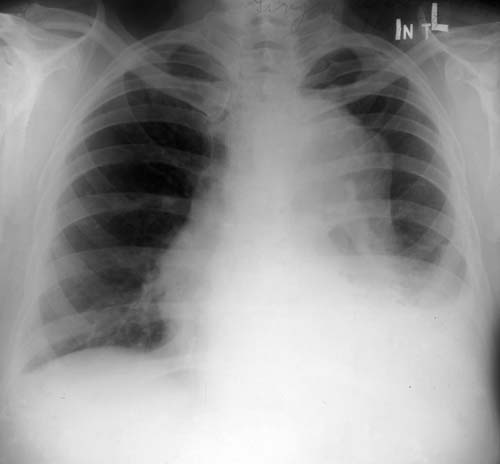 |
Obrázok
2C Výrazne rozšírený tieň hrudnej descendentnej aorty na skiagrame hrudníka zo
17. decembra 1999.
Figure 2C Chest roentgenogram demonstrates the evident widening of the thoracic
descending aorta |
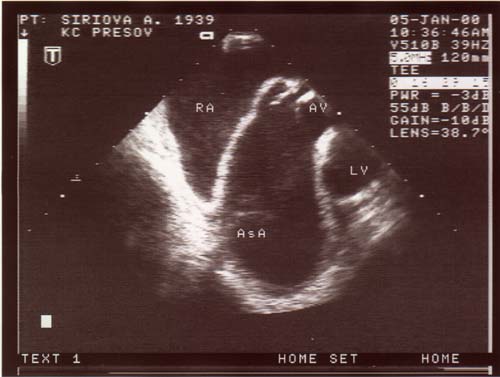 |
Obrázok
3A Dilatovaná ascendentná aorta pri transezofageálnom vyšetrení
v transverzálnej rovine bez príznakov disekcie. Aortálna chlopňa je
kalcifikovaná, so zníženou separáciou a maximálnym gradientom PG = 15,5 mHg
a Vmax = 1,97 m/s.
Figure 3A Dilated ascending aorta without any signs of dissection in the
transversal plane during transesophageal examination. The aortic valve is calcified with
diminished separation of the leaflets and maximal pressure gradient is 15.5 mmHg
(V max = 1,97 m/s). |
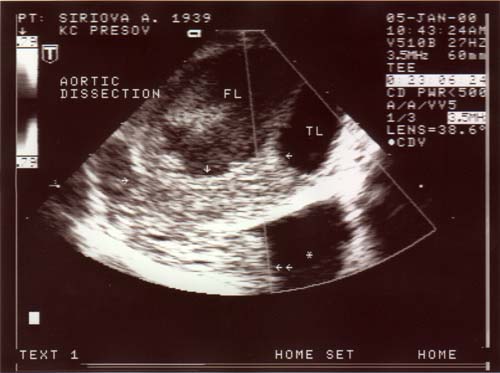 |
Obrázok
3B V distálnej časti hrudnej descendentnej aorty je zobrazený skutočný
kanál (TL) a trombus (ohraničený jednoduchými šípkami) v disekčnom
kanáli. V paraaortálnom priestore (*) je tiež zachytená trombotická masa
(dvojitá šípka), ktorá je v kontakte so zadnou aortálnou stenou.
Figure 3B In the distal part of the descending aorta true lumen (TL) and
thrombus (marked by simple arrows ) within a false lumen (FL) are visualised. Within
the paraaortic space (*) there is another thrombus (double arrow) in the vicinity
of the aortic posterior wall. |
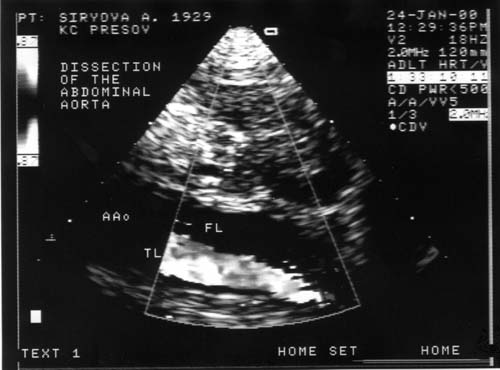 |
Obrázok
4 Brušná aorta s priemerom 3,2 cm. Disekčná membrána jednoznačne
vizualizovaná nebola, avšak farebným (i pulzným) dopplerom bol oddiferencovaný
dorzálne uložený skutočný kanál (TL), široký 1,5 cm, znázornený v systole
farebným tokom. Disekčný kanál (FL) je bez prítomnosti krvného toku.
Figure 4 Abdominal aorta with diameter of 3.2 cm. The intimal flap was not
depicted unambigvously, but during systole the true lumen (TL) was filled with blood (CFI
and PW doppler) compared with the false channel (FL) without detected blood flow. |
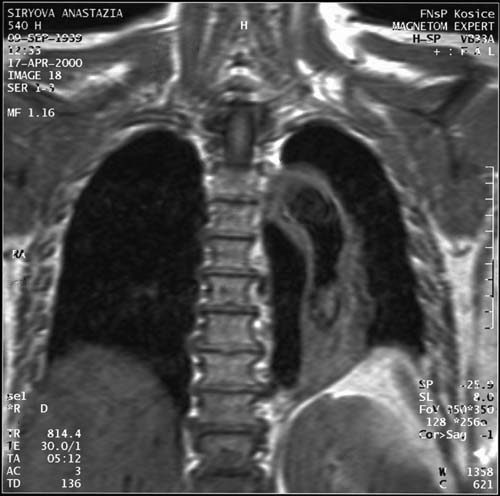 |
Obrázok
5 Hrudník vo frontálnej rovine pri vyšetrení nukleárnou magnetickou rezonanciou.
Zachytená je dilatovaná hrudná aorta od odstupu a. subclavia l. sin. až po bránicu.
V centrálnej časti je zachytený skutočný kanál; v dolnej časti vo
falošnom kanáli sa nachádza trombus.
Figure 5 Magnetic imaging scan in the frontal plane shows dilated thoracic
aorta from the origin of the left subclavian artery to the diaphragm. The true lumen is
located in the central part of the aorta. There is also a thrombus located in the false
lumen in distal part of the aorta. |
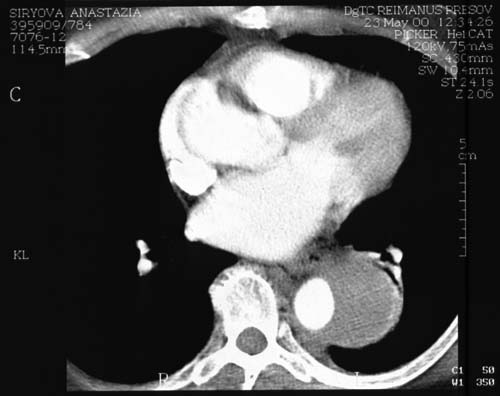 |
Obrázok
6 Špirálový CT sken hrudníka s kontrastom. Transverzálny sken zachytáva
dilatovanú, kontrastom vyplnenú ascendentnú aortu a dilatovanú descendentnú
aortu, v ktorej je pravý lúmen vyplnený kontrastom; falošný kanál je menej
denzný. Dorzálne je zachytená komunikácia s intrapleurálnym priestorom.
Figure 6 Axial CT scan with a contrast agent. There is a dilated
ascending aorta without any intimal flap and a dilated descending aorta, which is
divided by an intimal flap from the true lumen (filled by a contrast material) and
a false lumen. There is a communication between the aorta and the intrapleural space. |
 |
Tabuľka
1 Výsledky vyšetrenia punktátu z perikardiálneho vaku
Table 1 Values of the pericardial fluid examination |
 |
Tabuľka
2 Výsledky markerov na onkologické ochorenia
Table 2 Values of oncological markers |
 |
Tabuľka
3 Percentuálny výskyt menej typických a atypických prejavov disekcie
aneuryzmy aorty
Table 3 The prevalence of less typical and atypical symptoms during aortic
aneurysm dissection |
 |
Tabuľka
4 Senzitivita a špecifita zobrazovacích metód pri disekcii aorty
Table 4 Sensitivity and specificity of the imaging modalities detecting aortic
dissection |